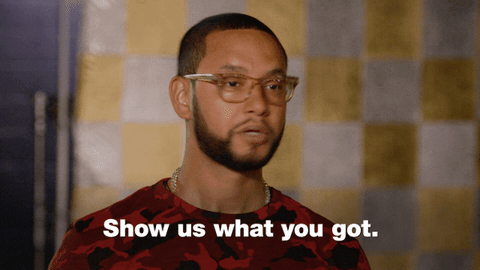- Human Skills Edition
- Posts
- One Simple Phrase That Turns Conflict into Collaboration
One Simple Phrase That Turns Conflict into Collaboration
FIRST THINGS FIRST:
Thank you for the feedback in Speak Up in Meetings—Even When the Environment Feels Unsafe, letting me know that scripts for phrasing challenging feedback constructively would help you navigate difficult meeting dynamics. I will share some next week.
Ever walk away from a conversation thinking:
“That could have gone better?” or “How could I have responded differently?”
Whether it’s misalignment with a partner, tension with a team member, or a brilliant idea that landed flat—communication breakdowns cost more than we admit.
Poor communication isn’t just annoying—it’s expensive.
It stalls progress, damages trust, and makes even great ideas easy to ignore.
The problem?
Most people double down on trying to be right…
Instead of learning how to keep the conversation moving.
Enter one of the most powerful tools borrowed from improv theater— The art of “Yes, And.”
“You can’t change what you don’t confront.”
In improv, “Yes, And” is a rule of survival.
It keeps the scene alive, the story building, and the players connected.
In work and leadership, it does something even more valuable: It transforms tension into possibility.
“Yes, And” isn’t about agreement. It’s about acknowledgment + addition.
You’re not conceding your perspective.
You’re signaling: “I heard you. I’m building on it.”
That’s how you earn the right to influence the direction of the conversation.

Gif by cbs on Giphy
I Like Examples, So Consider This:
You’re in a meeting. You float an idea.
A colleague immediately says, “That won’t work.”
Tension rises. The group shuts down. Progress stalls.
Now imagine the same moment—but instead, they respond with:
“Yes, that’s an interesting direction—and maybe we can also...”
The energy shifts.
Now you’re building, not battling.
The gold standard of business news
Morning Brew is transforming the way working professionals consume business news.
They skip the jargon and lengthy stories, and instead serve up the news impacting your life and career with a hint of wit and humor. This way, you’ll actually enjoy reading the news—and the information sticks.
Best part? Morning Brew’s newsletter is completely free. Sign up in just 10 seconds and if you realize that you prefer long, dense, and boring business news—you can always go back to it.
Why This Matters in High-Stakes Work
Subject matter experts and entrepreneurs are often the ones introducing change, offering critique, or proposing new paths.
Which means:
You’re often the one triggering resistance, intentionally or not.
“Yes, And” creates a psychological shift:
From opposition → to expansion
From defense → to curiosity
From “Me vs. You” → to “What can we build together?”
That's why you need a few sure-fire ways to apply “Yes, And” in everyday situations.

Gif by antmvh1 on Giphy

3 Ways I Use “Yes, And” to Transform Conflict into Collaboration
Let’s get it:
1. Start with acknowledgment—not rebuttal.
When someone shares an idea or concern, your instinct might be to counter it.
Instead, start with this:
“Yes, I see where you’re coming from—and there’s something we might layer onto that.”
This softens the ground for your perspective to land without negating theirs.
2. Use “Yes, And” to reframe unhelpful energy.
When conversations spiral into blame, sarcasm, or resistance, redirect with:
“Yes, that frustration is valid—and maybe it’s showing us where the pressure points are.”
It creates space for venting and momentum for solutions.
3. Build creative solutions in real time.
In moments of ideation or disagreement, “Yes, And” unlocks collaboration:
“Yes, your concern about budget makes sense—and if we phased the rollout, could we still test the core idea?”
You’ve now turned a barrier into a bridge.
You don’t have to agree with someone to affirm their perspective. 'Yes, And' is the bridge between acknowledgment and impact.
|
EXPERTS & ENTREPRENEURS:
Looking to build a lean, profitable internet business in 2025?
The Creator MBA delivers a complete blueprint for starting, building,
and sustaining a profitable Internet business.

POLL
In difficult conversations, which is your default? |
CURATED ROUNDUP
What Caught My Eye This Week
Book: Yes, And: How Improvisation Reverses "No, But" Thinking and Improves Creativity and Collaboration - Lessons from The Second City by Kelly Leonard and Tom Yorton
Get an earful of soft skills development when on the go with Blinkist.

The ability to turn tension into traction is what separates good communicators from trusted influencers.
Start practicing ‘Yes, And’ in the small moments—because how you speak in everyday tension is what earns you a seat at the table when it matters most.
Remember…
We’re wired to want to be seen, heard, and respected.
When people feel acknowledged, they become more open.
More willing to shift.
More likely to engage in problem-solving instead of power plays.
“Yes, And” works not because it’s polite.
It works because it changes the dynamic—from tug-of-war to co-creation.
Until next week, be easy!
Girvin
P.S. If you want a simple way to command attention, stand out in your niche or work, and build a loyal audience around your ideas, hit reply and send me a quick “command attention.”
Learn AI in 5 minutes a day
What’s the secret to staying ahead of the curve in the world of AI? Information. Luckily, you can join 1,000,000+ early adopters reading The Rundown AI — the free newsletter that makes you smarter on AI with just a 5-minute read per day.
What did you think of today's newsletter?Your feedback helps us make the best newsletter possible. |





